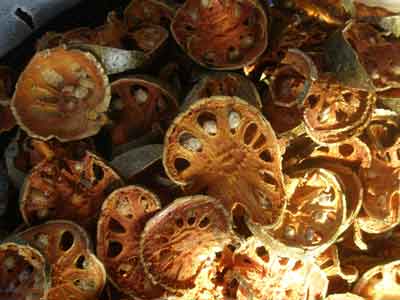Mud fish or snakehead fish, native to India, South East Asia, China and Africa. It is believed to be able to "walk on land". In fact, it has a rudimentary lung which enables it to live out of water, but it is unable to go wandering around the neighbourhood. This helps it through the sometimes long dry seasons of India and South East Asia. It can survive in the mud when other fish have perished. They are often fished from the mud rather than from the water. They are kept in fresh water for a while to clean them before eating. This fish is reputed to have an excellent flavour and is much used in Laos, Thailand and neighbouring countries. The colour is dark green, almost black and the fish is firm and relatively boneless. The head is often used for soups.
Mud fish or snakehead fish, native to India, South East Asia, China and Africa. It is believed to be able to "walk on land". In fact, it has a rudimentary lung which enables it to live out of water, but it is unable to go wandering around the neighbourhood. This helps it through the sometimes long dry seasons of India and South East Asia. It can survive in the mud when other fish have perished. They are often fished from the mud rather than from the water. They are kept in fresh water for a while to clean them before eating. This fish is reputed to have an excellent flavour and is much used in Laos, Thailand and neighbouring countries. The colour is dark green, almost black and the fish is firm and relatively boneless. The head is often used for soups.

Bael fruit; a close relative of the citrus. The fruit is about the size of, and has the appearance of a greyish-yellow orange with a thin woody rind. The floury pulp is pale orange in colour and has numerous seeds. Dried slices are soaked and boiled and the resulting liquid sweetened and drunk. Used for medicinal purposes.